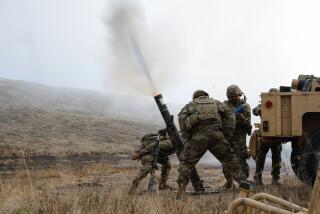Point Mugu Naval Base Under Attack From Mother Nature : Military: After pounding surf destroys three buildings, officials agree to abandon affected area.
The Point Mugu Navy base is under attack again: This time from the sea.
Powerful surf during this winter’s storms has eroded a sea wall, swallowed a beach road and destroyed three buildings on the spit of sand between the Pacific Ocean and Mugu Lagoon.
The Navy burned two of the crumpled buildings so their splintered remains would not add to the debris cluttering the beach.
And now, the Navy has decided to make a strategic retreat as the advancing forces of nature are poised to claim the officers’ club as the next casualty.
“We’ve decided that we can’t beat Mother Nature,” said Capt. Thomas M. Boothe, public works officer for the base, which recently survived Pentagon cutbacks. “The right thing to do is to remove the sea wall and restore this to a beach.”
The culprit behind the accelerating erosion lurks on the bottom of the ocean.
A trench, which plunges 1,000 feet deep not far from land, is slowly marching toward shore. Acting like a sinkhole, the trench sucks in everything that stands in its path.
The head wall of the underwater canyon lies a few car lengths from shore, Boothe said, pulling sand and protective boulders down its steep banks. The result has stripped the area of its beach and undermined a training building, an old laundry, a concrete-block bathroom and now the officers’ club.
Part of the problem has been the 15-foot-high wall of boulders installed in the 1960s and 1970s to protect the Navy buildings a few miles down the coast from Oxnard.
An architectural engineering firm pointed out that the sea wall only exacerbated the problem by disrupting the normal ebb and flow of sand that used to keep the breakers a safe distance away.
Following the firm’s recommendations, the Navy plans to remove a stretch of the rock sea wall so the beach can re-establish itself in a gentle slope that will slow the advancing canyon.
“It will still erode toward the beach, but slower, if it is a flatter slope,” Boothe said.
Boothe said he was warned about the marine canyon when he arrived at Point Mugu in 1992. “I thought, well, in geologic time, someone in the future will have to deal with this.”
That winter, the rock sea wall sank eight feet. Work crews patched up the wall with another layer of boulders.
*
The fortifications held until this winter’s storms.
At 2:30 a.m. Jan. 5, Boothe got a frantic telephone call: The marine assault had resumed. Huge waves crashed over the sea wall and battered the closest buildings. The pitching seas tossed boulders through the windows of the officers’ club. Ocean water swamped the downstairs dance floor with knee-deep water.
“When I first came down here, it looked like a war zone,” said Cora Scott, a community relations officer who used to manage the officers’ club.
With cleanup and repair costs reaching into the millions of dollars, the area still has the look of a disaster. The rubble of the training building remains a twisted tangle of pipes, rusting metal and hunks of concrete.
*
The stilts of the laundry poke out of the sand, the only portion remaining after the Fire Department doused it with fuel oil and lit a match.
The windows are boarded up in the officers’ club, and signs restrict access to cleanup crews.
In coming months, workers will reroute water and sewer lines and remove the remnants of asphalt from the old beach road so it can return to a natural beach.
After that, the Navy will remove the sea wall and stand back to let nature take its course, said Capt. Roger Hull, vice commander of the base.
“We are not going to waste the taxpayers’ money by rebuilding something that is going to be washed away in the next year or two,” he said.
More to Read
Sign up for Essential California
The most important California stories and recommendations in your inbox every morning.
You may occasionally receive promotional content from the Los Angeles Times.









